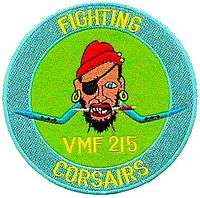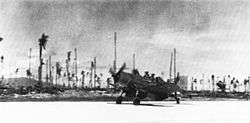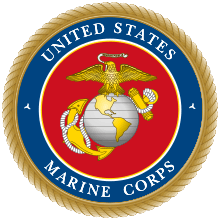VMF-215
Marine Fighting Squadron 215 (VMF-215) was a fighter squadron of the United States Marine Corps that was activated and fought during World War II. Known as "The Fighting Corsairs", they fought in many areas of the Pacific War, including the Battle of Bougainville. During their four-and-a-half month tour, the squadron was credited with shooting down 137 enemy aircraft, fourth most in Marine Corps aviation history.[1][2]
| Marine Fighting Squadron 215 | |
|---|---|
 VMF-215’s Insignia | |
| Active |
|
| Country | United States |
| Branch | USMC |
| Type | Fighter squadron |
| Role | Air interdiction Close air support |
| Part of | Inactive |
| Nickname(s) | "Fighting Corsairs" |
| Engagements | World War II * Battle of Empress Augusta Bay |
| Aircraft flown | |
| Bomber | SBD Dauntless |
| Fighter | F4F Wildcat F4U Corsair F6F Hellcat |
Following the surrender of Japan, the squadron was deactivated on November 13, 1946 . The squadron was reactivated in the Marine Forces Reserve and was based out of Naval Air Station Olathe, Kansas until its deactivation on January 30, 1970.
History
The squadron was activated on March 1, 1942, as Marine Scout Bomber Squadron 244 (VMSB-244). On September 14 of that same year they were re-designated Marine Scout Bomber Squadron 242 (VMSB-242) only to be changed again the next day to its final name, Marine Fighting Squadron 215.[3] They trained at Marine Corps Air Station Santa Barbara, California[4] prior to deploying and during this time transitioned from the SBD Dauntless dive bomber to the F4F Wildcat.

The squadron departed the United States on February 23, 1943, and was first sent to Marine Corps Air Station Ewa, Hawaii. During their time at MCAS Ewa they again transitioned aircraft, this time receiving the F4U Corsair. The squadron departed Hawaii on May 12 for Midway Atoll where they stayed for two months flying combat air patrols and escorting Allied shipping in the area. In mid-June 1942 they left Midway for the South Pacific.[5]
VMF-215 arrived on Espiritu Santo on July 1, 1943, and by the end of the month was taking part in fighter sweeps against Japanese bases in the northern Solomon Islands.[5] On August 14, an F4U Corsair from VMF-215 was the first plane to arrive at the newly captured Munda airfield where they immediately began operating to cover the landings on Vella Lavella.[6] Shortly thereafter the squadron pulled back to the rear for rest and relaxation.[5]
The squadron’s second combat tour began while they were based at Barakoma Airfield on Vella Lavella. From there they covered the landings at Empress Augusta Bay on Bougainville, which began on November 1, 1943.[7] By January 27, 1944 the squadron was operating from Torokina Airfield on Bougainville and from there the squadron took part in air strikes against the Japanese garrison at Rabaul, the Japanese naval base at Kavieng, New Ireland and against Japanese shipping near the Bismarck Archipelago.[5] During this time VMF-215 established four new Marine records in the South Pacific by downing 137 Japanese planes in 18 weeks, 87 planes shot down in one month, 106 planes destroyed in a single 6-week tour and 10 aces in one squadron.[2][8][9]

As action in the Solomons drew to a close the squadron was sent to Turtle Bay Airfield where it was not deactivated but existed only on paper for a few weeks.[10] They were reformed on May 7, 1944, and were sent to Emirau on August 5, 1944.[7] From there they moved to Guadalcanal on their way back to the United States where they eventually arrived on October 20, 1944.[3] Upon arrival at Marine Corps Air Station El Toro, California, the unit was deactivated on November 6; however, they were reactivated again on November 21 and became a carrier training replacement unit.[10] Following the end of World War II, the squadron was deactivated on November 13, 1945.
VMF-215 was later brought back as a squadron in the Marine Forces Reserve and were based out of Naval Air Station Olathe in Kansas. They were never recalled to active duty and were decommissioned for the last time on January 30, 1970.
Notable former members
- Robert M. Hanson – 25 kills and Medal of Honor recipient
- Donald N. Aldrich – 20 kills
- Harold L. Spears – 15 kills
- Robert G. Owens Jr. – 7 kills, 5 probables
- A. Roger Conant – 6 kills, 3 probables
- Harold A. "Hap" Langstaff Jr. – 3 kills
Unit awards
A unit citation or commendation is an award bestowed upon an organization for the action cited. Members of the unit who participated in said actions are allowed to wear on their uniforms the awarded unit citation. VMF-215 was presented with the following awards:
| Ribbon | Unit Award |
| Navy Unit Commendation | |
| Asiatic-Pacific Campaign Medal | |
| World War II Victory Medal | |
| National Defense Service Medal with one Bronze Star |
See also
Notes
- Sherrod, History of USMC Aviation in WWII, p. 430.
- Mersky (1993). ""Other Marine Aces"". Time of Aces: Marine Pilots in the Solomons. Retrieved 2007-12-02.
- Rottman, USMC WWII OOB, p. 442.
- Shettle, USMC Air Station of WWII, p. 147.
- Crowder, USMC Aviation Squadron, p. 74.
- Melson, Charles D. (1993). Up the Slot: Marines in the Central Solomons. Marines in World War II Commemorative Series. Washington, D.C.: Marine Corps Historical Center. Retrieved 2007-12-01.
- Sherrod, History of USMC Aviation in WWII, p. 461.
- Dechant, Devilbirds, p. 134.
- Tillman, Corsair, p. 63.
- Crowder, USMC Aviation Squadron, p. 75.
References
- Bibliography
- Crowder, Michael J. (2000). United States Marine Corps Aviation Squadron Lineage, Insignia & History – Volume One – The Fighter Squadrons. Paducah, KY: Turner Publishing Company. ISBN 1-56311-926-9.
- De Chant, John A. (1947). Devilbirds – The Story of United States Marine Aviation in World War II. New York: Harper & Brothers. pp. 4–5.
- Mersky, Cmdr Peter B., USNR (1993). Time of Aces: Marine Pilots in the Solomons. Marines in World War II Commemorative Series. Washington, D.C.: Marine Corps Historical Center. Retrieved 2007-12-02.CS1 maint: multiple names: authors list (link)
- Rottman, Gordon L. (2002). U.S. Marine Corps World War II Order of Battle – Ground and Air Units in the Pacific War, 1939 – 1945s. Greenwood Press. ISBN 0-313-31906-5.
- Sherrod, Robert (1952). History of Marine Corps Aviation in World War II. Washington, D.C.: Combat Forces Press.
- Shettle Jr., M. L. (2001). United States Marine Corps Air Stations of World War II. Bowersville, Georgia: Schaertel Publishing Co. ISBN 0-9643388-2-3.
- Tillman, Barrett (2001). Corsair: The F4U in World War II and Korea. Annapolis, Maryland: Naval Institute Press. ISBN 1-55750-994-8.
- Web
- VMF-215 squadron history
- "Fighting Squadrons of the USMC in WWII". www.acepilots.com. Retrieved 2007-12-01.
External links
- Information of a wrecked VMF-215 F4u Corsair that has been located
- Images of Capt. Conant and his F4U
- http://www.pacificwrecks.com/aircraft/f4u/56260.html Information on lost F4U Corsair on 3 Sept 1944. Pilot 2nd Lt Arthur Patet, USMCR. Aircraft and pilot never found after crash at Lassuk Bay, New Ireland, PNG
- Information from USMC Archives and JPAC. (R.A. Clark, USMC)
